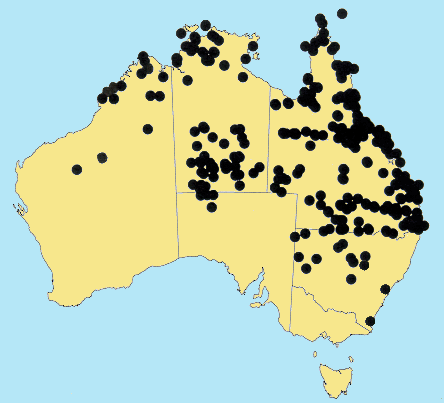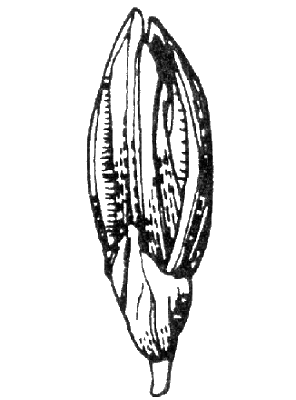Urochloa subquadripara* (Trin.) R.D.
Webster. Lingnan Sci. J. 7: 214 (1931).
Classification.
(GPWG 2001) : Subfamily Panicoideae. Paniceae.
Basionym and/or
Replacement Name: Panicum
subquadriparum Trin., Gram. Panic. 145 (1826).
Type of Basionym or
Protologue Information: LT: Chamisso s.n., LT designated by ?; cited
by Veldkamp, Blumea 41: 426 (1996).
Recent synonyms:
B. miliiformis, Brachiaria subquadripara
Key references
(books and floras): [1952] C.A.Gardner, Flora of Western Australia 1
Gramineae (237 as Brachiaria miliiformis), [1981] M.Lazarides in
J.Jessop (ed)., Flora of Central Australia (475 as Brachiaria
miliiformis), [2002] D.Sharp & B.K.Simon, AusGrass, Grasses of
Australia (as Brachiaria), [2006] J.Jessop, G.R.M.Dashorst,
F.M.James, Grasses of South Australia (431 as Brachiaria), [2008]
S.W.L.Jacobs, R.D.B.Walley & D.J.B.Wheeler, Grasses of New South Wales.
Illustrations:
[2006] J.Jessop, G.R.M.Dashorst, F.M.James, Grasses of South Australia (431, fig. 361 as Brachiaria), [2008]
S.W.L.Jacobs, R.D.B.Whalley & D.J.B.Wheeler, Grasses of New South Wales,
4th edn (396).
Habit. Annual
or perennial. Rhizomes absent. Stolons absent or present. Culms prostrate,
10–200 cm tall. Ligule a fringe of hairs. Leaf-blades linear or lanceolate,
2–20 cm long, 4–10 mm wide. Leaf-blade surface glabrous.
Inflorescence.
Inflorescence compound, a panicle of racemes. Racemes 3–5, 2–6 cm long, 2–3 mm
wide. Central inflorescence axis 2.5–10 cm long.
Spikelets.
Spikelets sessile. Fertile spikelets 2-flowered, the lower floret barren
(rarely male), the upper fertile, comprising 1 basal sterile florets, comprising
1 fertile floret(s), without rachilla extension, elliptic, dorsally compressed,
3–3.7 mm long. Rhachilla internodes elongated between glumes.
Glumes. Glumes
dissimilar, thinner than fertile lemma. Lower glume ovate, membranous, without
keels, 5–11 -nerved. Upper glume oblong, 2.8–3.4 mm long, membranous, without
keels, 5–7 -nerved. Upper glume surface glabrous. Upper glume apex muticous. Florets.
Basal sterile florets 1, barren, with palea or without significant palea. Lemma
of lower sterile floret 100 % of length of spikelet, membranous, 5 -nerved.
Fertile lemma 2.8–3.5
mm long, without keel. Lemma apex mucronate. Palea without keels.
Continental
Distribution: Africa, Temperate Asia, Tropical Asia, Australasia, Pacific,
and South America.
Australian
Distribution: Western Australia, Northern Territory, South Australia,
Queensland, New South Wales, Christmas Is.
Western Australia: Gardner, Dampier.
Canning, Fortescue, Austin. Northern Territory:
Darwin & Gulf, Barkly Tableland, Central Australia North, Central
Australia South. South Australia:
North-western, Lake Eyre, Gairdner-Torrens
Basin, Eastern. Queensland: Burke, Burnett, Cook, Darling Downs,
Gregory North, Leichhardt, Maranoa, Mitchell, Moreton, North Kennedy, Port
Curtis, South Kennedy, Warrego, Wide
Bay, Gregory South. New
South Wales: North-Western Slopes, Central-Western Slopes, North-Western
Plains, South-Western Plains, North Far Western Plains.
Notes.
Close relatives include U. distachya and U. piligera, however, it
is distinguished by spikelet length and presence of a palea in the lower
floret.
Introduced; W.A.,
N.T., and Qld. Native to tropical Africa and Asia
but widely occurs as a weed. In tropical and subtropical rain forests, tropical
and subtropical sub-humid woodlands, and coastal grasslands. Flowers throughout
the year.



